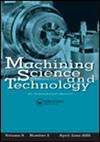使用生物模拟结构化工具对车削过程进行有限元建模和实验验证,以获得与工业相关的结果
IF 2.6
4区 工程技术
Q2 ENGINEERING, MANUFACTURING
引用次数: 0
摘要
摘要马氏体不锈钢因其高硬度、高强度、耐腐蚀等优异性能,广泛应用于航空航天、医疗、石油和天然气等行业。然而,由于其高硬度和低导热性导致高切削力要求和刀具磨损,这种工作材料的加工变得困难。结构化刀具的应用是近年来提高加工材料可加工性的可持续加工技术之一。大多数研究人员只研究了传统结构几何的影响,主要集中在实验上。但是,进行实验需要庞大而昂贵的实验装置,也需要耗费大量的时间。仿生几何形状和各种几何参数对马氏体AISI 420钢加工特性的影响也没有研究。因此,有限元建模被证明是一种有益的技术,因为它节省了时间和精力。在本研究中,建立了三维有限元模型,以考察不同几何结构刀具在提高AISI 420钢可加工性中的性能。采用Johnson cook (JC)材料模型对工件进行建模。首先,将仿真得到的切向力与实验得到的切向力进行了验证,常规刀具和仿生结构化刀具的切向力误差分别为6.65%和5.57%,表明了加工模型的适用性。进一步研究了仿生新月形结构、酒窝结构和凹槽结构等不同结构形状对切削力、有效应力和切削温度的影响,发现新月形结构刀具在降低切削力、有效应力和切削温度方面具有较好的效果。在得到优越的几何形状即月牙形结构几何形状后,考察了月牙形结构参数(半径、边缘距离)的变化对上述加工响应的影响。结构参数的变化显著影响了各种输出响应,表明仿生结构刀具在改善AISI 420钢的加工性能方面具有很大的潜力。本文章由计算机程序翻译,如有差异,请以英文原文为准。
Finite element modeling and experimental validation of turning process using bio-mimicked structured tool for outcomes relevant to industry
Abstract Martensitic stainless steels are extensively used in aerospace, medical, and oil and gas industries because of their superior properties such as high hardness, strength, and corrosion resistance properties. However, the machining of this work material becomes difficult due to its high hardness and low thermal conductivity leading to high cutting force requirements and tool wear. Recently, the application of structured tools is one of the sustainable machining techniques used to enhance the machinability of work materials. Most of the researchers have studied only the influence of conventional structured geometries and have mainly concentrated on experiments. But the conduction of experiments involves bulky and costly experimental setups and also consumes a lot of time. Also, the bio-mimicked geometrical shapes and various geometrical parameters of structured tools on machining characteristics of martensitic AISI 420 steel have not been studied. Therefore finite element (FE) modeling proves to be a beneficial technique as it saves time and effort. In the current investigation, a 3D FE model is developed to examine performance of different geometrical structured tools in improving the machinability of AISI 420 steel. Johnson cook (JC) material model is utilized for modeling workpiece. Initially, the tangential force results obtained through simulation are validated with tangential forces obtained through experiments with an error of 6.65% using conventional tool and 5.57% using bio-mimicked structured tool, indicating the suitability of the machining model. Further, the effect of various structure shapes, mainly bio-mimicked crescent structure, dimple structure, and groove structure, was studied, and it is noticed that crescent-structured tool depicted better performances in lowering cutting force, effective stress, and cutting temperature. After getting superior geometry, i.e., crescent-structured geometry, the influence of variation in crescent structure parameters (radius, edge distance) was examined to study its influence on the above-mentioned machining responses. The variation in structure parameters significantly influences various output responses, indicating that bio-mimicked structured tools have a lot of potential to improve the machining performance of AISI 420 steel.
求助全文
通过发布文献求助,成功后即可免费获取论文全文。
去求助
来源期刊

Machining Science and Technology
工程技术-材料科学:综合
CiteScore
5.70
自引率
3.70%
发文量
18
审稿时长
6 months
期刊介绍:
Machining Science and Technology publishes original scientific and technical papers and review articles on topics related to traditional and nontraditional machining processes performed on all materials—metals and advanced alloys, polymers, ceramics, composites, and biomaterials.
Topics covered include:
-machining performance of all materials, including lightweight materials-
coated and special cutting tools: design and machining performance evaluation-
predictive models for machining performance and optimization, including machining dynamics-
measurement and analysis of machined surfaces-
sustainable machining: dry, near-dry, or Minimum Quantity Lubrication (MQL) and cryogenic machining processes
precision and micro/nano machining-
design and implementation of in-process sensors for monitoring and control of machining performance-
surface integrity in machining processes, including detection and characterization of machining damage-
new and advanced abrasive machining processes: design and performance analysis-
cutting fluids and special coolants/lubricants-
nontraditional and hybrid machining processes, including EDM, ECM, laser and plasma-assisted machining, waterjet and abrasive waterjet machining
 求助内容:
求助内容: 应助结果提醒方式:
应助结果提醒方式:


